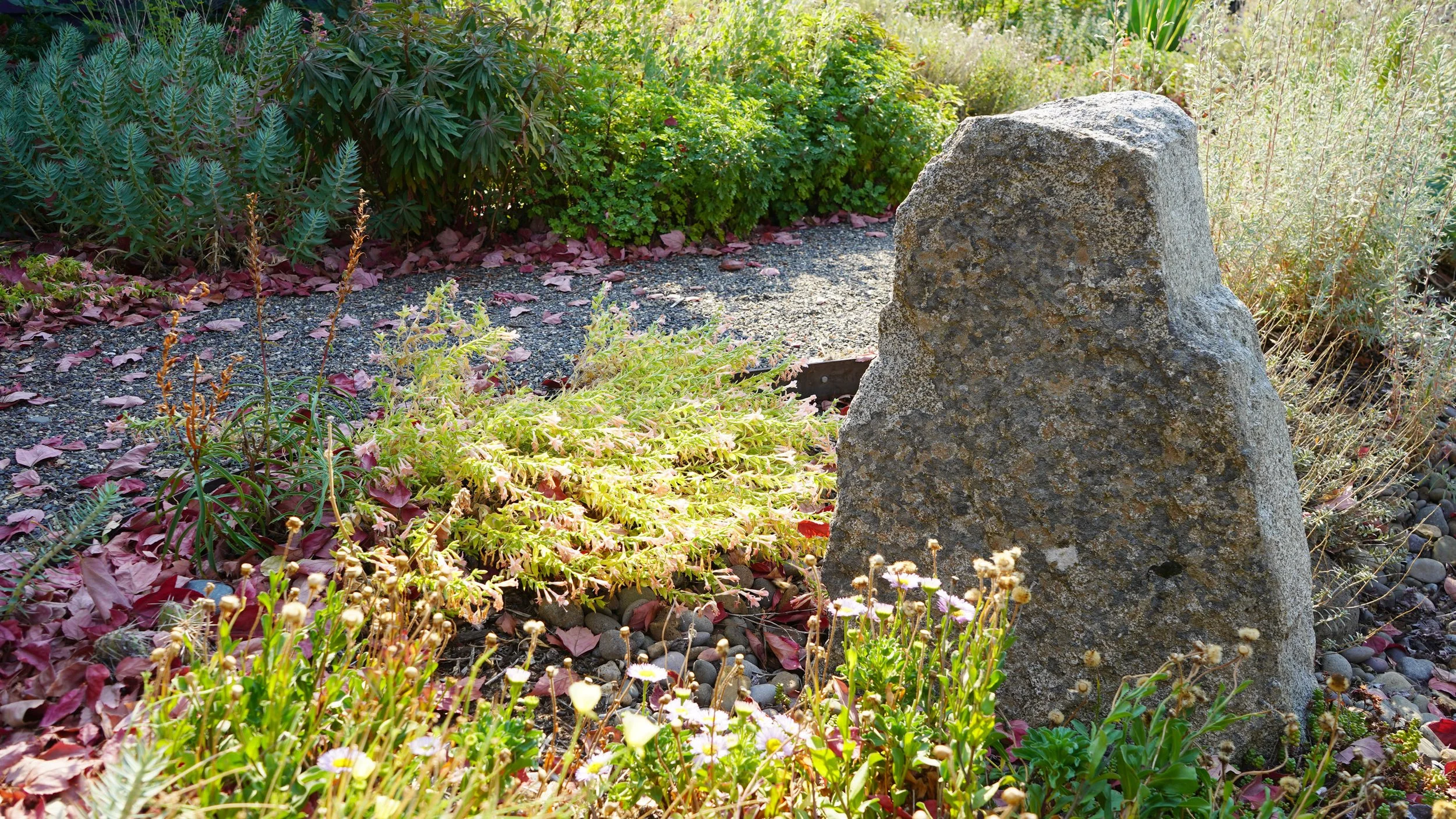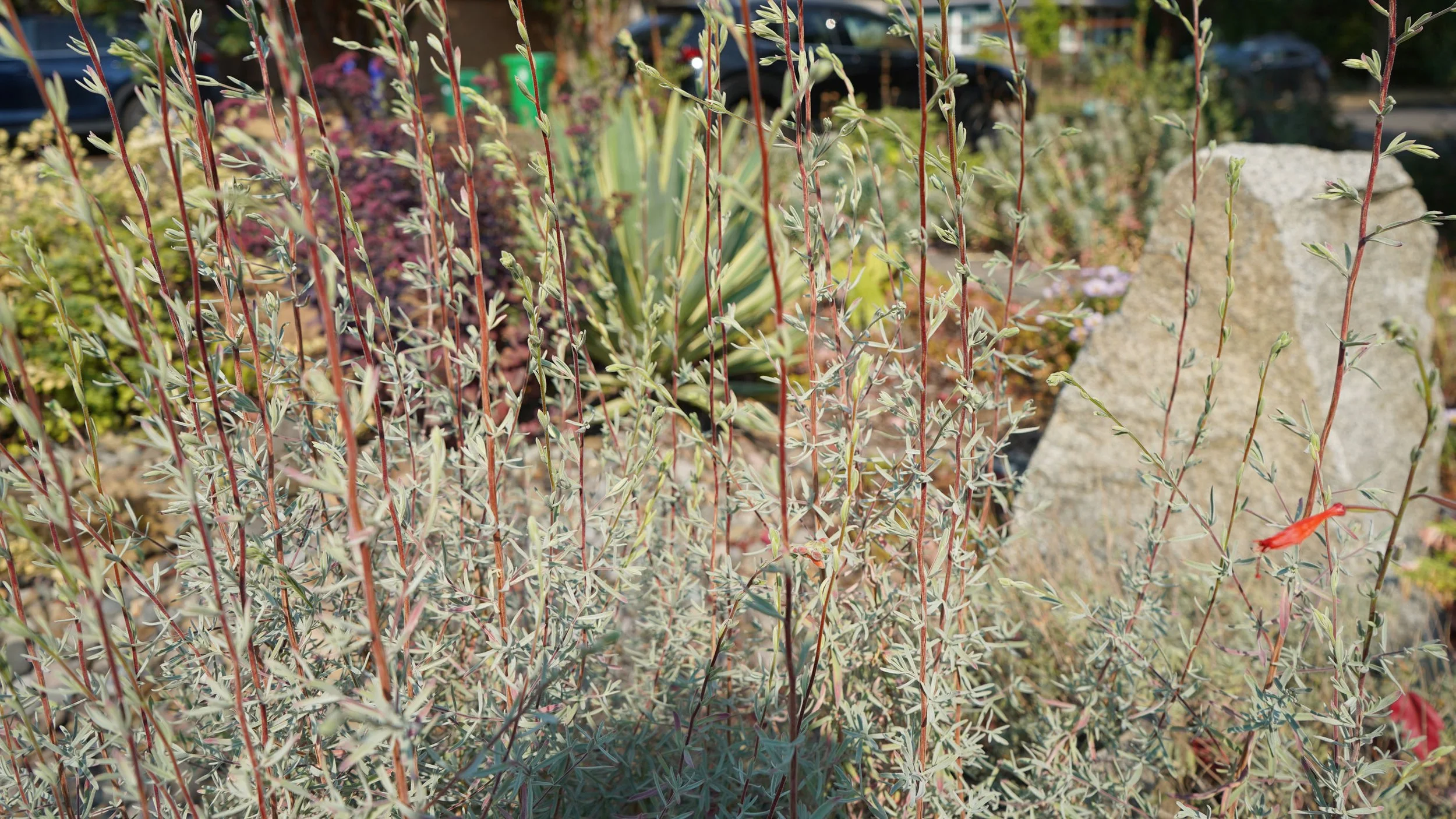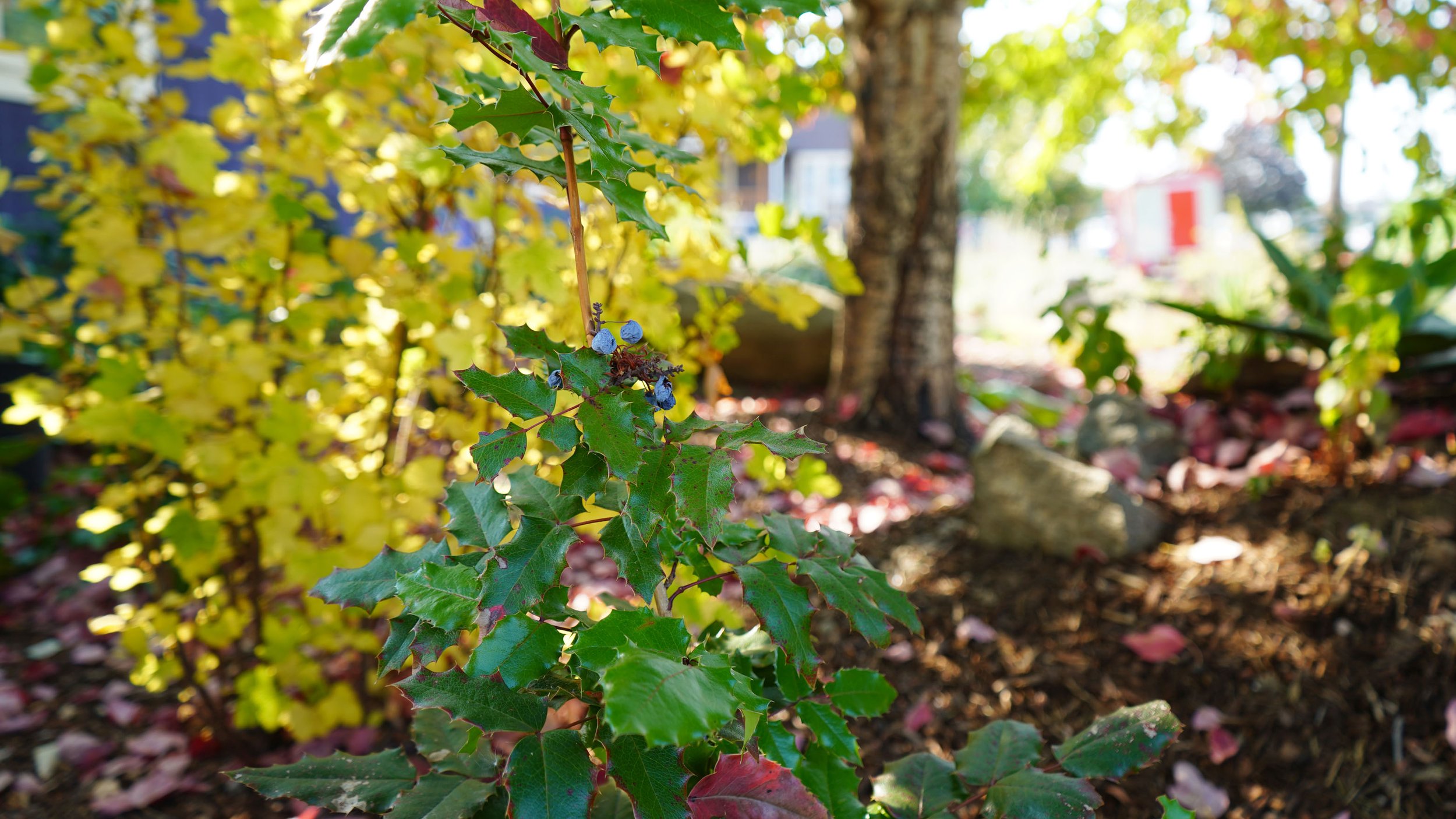FALL GARDEN CARE: THE ART OF STRATEGIC MESS
NOVEMBER | 11.07.25
November Nuance: The Leave-Some-Leaves Philosophy
November in Portland brings that specific kind of rain that makes you question every life choice that led to you standing outside with a rake. The leaves are down. All of them. Your lawn looks like it's wearing a thick blanket, and your neighbors are out there with leaf blowers at 7 AM like it's some kind of emergency.
Here's what I want you to know: You don't need to rake everything. But you also shouldn't leave everything. Welcome to ecological gardening, where the answer to almost everything is "it depends."
The truth? Leaves are gold for your soil and essential habitat for overwintering insects. But a six-inch blanket of maple leaves smothering your perennials? That's not habitat. That's suffocation.
We need nuance. We need strategy.
We need to stop treating our yards like they're either pristine golf courses or untouched wilderness and start treating them like the managed ecosystems they actually are.
Where to Leave Leaves (And Why)
Garden Beds: Leave Them
In your perennial beds, shrub borders, and around the base of trees, leave the leaves. A 2-3 inch layer of leaf litter is perfect. Why this works:
Provides insulation for plant roots through freeze-thaw cycles
Creates overwintering habitat for native bees, butterflies, beetles, and beneficial insects
Breaks down slowly, feeding soil microbes and adding organic matter
Suppresses weed germination in spring
Retains moisture during dry spells
Native bees, including mason bees and leafcutter bees, often overwinter in hollow plant stems and leaf litter. When you leave leaves in garden beds, you're providing life support for next year's pollinators.
Under Shrubs and Trees: Definitely Leave Them
This is non-negotiable for me. Leaves under woody plants mimic what happens in nature. Forest floors aren't raked clean. Why this works:
Trees and shrubs evolved with leaf litter. Their root systems expect it
Mycorrhizal fungi thrive in undisturbed leaf layers
Provides habitat for ground beetles, spiders, and other pest-eating predators
Creates refuge for Pacific chorus frogs, salamanders, and beneficial creatures
Slowly releases nutrients back to the plants that created them
Where to Move Leaves (And Why)
Lawns: Move Them
A thick mat of wet leaves on your lawn will smother the grass, create anaerobic conditions, encourage fungal disease, and leave you with dead patches come spring.
Options:
Mulch them in place with a mower: Run over leaves with a mulching mower when they're dry. The shredded leaves filter down into the turf, feeding the soil.
Rake them into beds: My preferred method. Rake leaves off the lawn and distribute them into garden beds or around shrubs.
Create a leaf pile habitat: Designate a corner of your yard for a leaf pile. This becomes premium overwintering habitat while creating leaf mold.
Paved Surfaces, Water Features, and Gutters: Remove Them
Leaves on hardscape are slippery and clog drains. Leaves in ponds and gutters create problems. Move them to beds or your leaf pile where they're useful.
The Aesthetic Question (And the Mulch Solution)
Let's be real: We've been trained to see bare soil as "clean" and leaf litter as "messy." But I'd argue that a garden bed with a natural layer of leaves looks intentional and cared-for. There's texture. There's evidence that something real is happening in your soil.
However, if you just can't handle the aesthetic of leaves:
The Mulch-After-Leaves Strategy
Here's the compromise. Wait until all the leaves have dropped (usually late November into early December in Portland). Once leaf drop is complete:
Let leaves sit for 2-3 weeks minimum. This gives overwintering insects time to settle into the leaf layer.
Don't remove the leaves. Leave them right where they are in your beds.
Top-dress with 1-2 inches of decorative mulch (arborist wood chips, shredded bark, or leaf mold). Spread the mulch over the leaf layer.
What this does:
Covers the "messy" leaves with a uniform, intentional-looking layer
Keeps all the ecological benefits: the leaves are still there, still breaking down, still providing habitat
The mulch layer holds the leaves in place
Creates a finished look that satisfies conventional aesthetic standards
Insects sheltering in the leaf layer remain undisturbed under the protective mulch blanket
This is the compromise. You get the soil health, the habitat value, and the ecological function while also getting a garden that looks "done."
The Nuance: Plant-Specific Considerations
Not all plants tolerate heavy leaf cover equally.
Plants That Can Handle Heavy Leaf Cover:
Native woodland perennials (Trillium, Wild Ginger, Sword Fern)
Established shrubs and trees
Spring bulbs (they'll push right through)
Ornamental grasses
Plants That Need Leaves Pulled Back:
Mat-forming perennials prone to crown rot (Phlox, some Sedums)
Evergreen perennials with basal rosettes (Heuchera, Epimedium)
Newly planted perennials (first year)
Alpine and rock garden plants
The rule: If a plant evolved in wet, dense forests (like our natives), it can handle leaves. If it evolved in drier, more open conditions, pull leaves back from the crown but leave them nearby.
Soil Health: What November Leaves Do for You
When leaves stay on the ground, they become food for an entire ecosystem of decomposers:
Fungi break down lignin and cellulose
Bacteria process simpler compounds
Earthworms pull leaves underground, mixing organic matter deep into soil
Millipedes, sowbugs, and springtails shred leaves into smaller pieces
Beetles and their larvae continue the breakdown process
By spring, those leaves have transformed into humus, a stable form of organic matter that:
Improves soil structure
Increases water retention
Provides slow-release nutrients
Feeds beneficial soil microbes
This is free fertility. You're not buying compost. You're not buying fertilizer. You're letting the system do what it evolved to do.
November Soil Prep: Beyond Leaves
What I Do:
1. Add compost to beds I top-dress garden beds with 1-2 inches of finished compost in November. This gives soil biology something to work on over winter.
2. Plant garlic and cover crops November is perfect for planting garlic. I also sow cover crops (crimson clover, hairy vetch) in fallow beds.
3. Mulch paths with wood chips I refresh paths with arborist wood chips. This suppresses weeds and keeps mud contained during our wet season.
4. Don't till Tilling destroys soil structure and kills beneficial fungi. I layer organic matter on top and let soil organisms incorporate it.
The Leaf Pile: Creating Premium Habitat
If you have space, create an intentional leaf pile. This is strategic habitat creation.
How to Make a Good Leaf Pile:
Location: Near a fence line, behind a shed, or in a back corner.
Size: At least 3 feet x 3 feet x 3 feet. Larger is better.
Composition: Mostly leaves, plus small twigs and plant stems. Avoid anything diseased.
Leave it alone: Don't turn it. Don't disturb it until late spring. This is overwintering habitat.
And What Uses Your Leaf Pile:
Native bees and beneficial wasps
Overwintering butterflies and moths
Beetles and their larvae
Salamanders
Ground beetles (which eat pest insects)
By late spring/early summer, the bottom layers transform into leaf mold, a beautiful soil amendment.
What About Diseased Leaves?
Most leaf diseases don't survive winter in leaf litter, especially in our wet climate.
Exceptions where you should remove and dispose leaves:
Apple scab (from apple trees with severe infections)
Fire blight (from infected pear or apple trees)
Rose black spot (from heavily infected roses)
Tar spot (from maples, though this is mostly cosmetic)
For most gardens, leaving leaves doesn't increase disease pressure. The diverse microbial life in healthy leaf litter often outcompetes pathogens.
Your November To-Do List
Leave leaves in:
Garden beds (2-3 inch layer)
Under trees and shrubs
Woodland and native plant areas
Designated leaf pile
Move leaves from:
Lawns (mulch in place or rake into beds)
Paved surfaces (sweep into beds)
Water features and gutters
Pull leaves back from:
Plant crowns prone to rot
Evergreen perennial rosettes
Newly planted perennials
Optional aesthetic finish:
Wait 2-3 weeks after leaves drop
Top-dress leaf layer with 1-2 inches decorative mulch
Creates finished look while maintaining ecological function
Other November tasks:
Top-dress beds with compost
Plant garlic
Sow cover crops in fallow beds
Mulch paths with wood chips
Do NOT till
Let Us Handle the Strategic Mess
Look, I know this is nuanced. I know it's a lot to think about when you're standing in the rain watching leaves blow around your yard. That's exactly why we created our Seasonal Fine Gardening program.
We come to your property seasonally (spring, summer, fall, winter) and handle all the ecological management your garden needs: strategic leaf placement, seasonal mulching, soil amendments, cover crop installation, native plant care, and all the other tasks that keep a regenerative garden thriving.
We understand which leaves to leave and where. We know which plants need what kind of attention. We manage for soil health AND aesthetics because we know you need both.
This isn't mow-and-blow maintenance. This is ecological stewardship that makes your garden more beautiful and more functional with each season.
If you're tired of guessing whether you're doing it right, or if you simply don't have time to manage the nuance, we'd love to help.
Ready to hand this off to people who geek out about leaf placement and soil biology?
Contact us to learn more about our Seasonal Fine Gardening program.
We're currently booking for our winter/spring season.
info@be.land
www.be.land
The Question That Matters
Instead of asking "Should I rake my leaves?" ask this: "Where can these leaves do the most good?"
That question shifts you from following rules to thinking ecologically. And that's where real garden health begins.
November isn't about cleaning up. It's about setting the stage for what happens next.This is the work. Not raking is work. Strategic mess is work. Understanding nuance is work.
And if you'd rather have someone else do this work while you enjoy the results? That's what we're here for.
With gratitude for the rain, the leaves, and the patience to let things decompose,
Brit Sastrawidjaja
Founder, Blueprint Earth
Regenerative Beetender
P.S. Whether you DIY or work with us, if you create a leaf pile this November or try the mulch-over-leaves technique, send me a photo. Tag @theblueprintearth on Instagram. I want to see your strategic mess (or your aesthetically pleasing ecological compromise).






